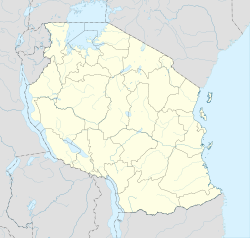Nduruma, is a administrative ward in Arusha Rural District in the east Arusha Region of Tanzania. It is bordered to the north by Mlangarini, to the south by Bwawani, and to the east by Kikwe ward of the Meru District. The ward covers an area of 62.72 square kilometres (24.22 sq mi) with an average elevation of 1,041 metres (3,415 ft).[1][2]
Nduruma
Kata ya Nduruma | |
|---|---|
| Coordinates: 3°29′28″S 36°48′44″E / 3.491111°S 36.812222°E | |
| Country | |
| Region | Arusha Region |
| District | Arusha Rural District |
| Established | 1984 |
| Government | |
| • Type | Council |
| Area | |
• Total | 62.72 km2 (24.22 sq mi) |
| Elevation | 1,041 m (3,415 ft) |
| Population (2012) | |
• Total | 12,042 |
| • Density | 190/km2 (500/sq mi) |
| Time zone | EAT |
| Area code | 027 |
| Website | District Website |
In 2012 national census there were 12,042 people in the ward, from 10,316 in 2002 when it was part of the former Arumeru District. The ward has 190 inhabitants per square kilometre (490/sq mi).[3][4]
The Nduruma River flows from near the top of Mount Meru down to Nduruma. There are three groups of farmers on the river in competition for the water rights of the river. Local small scale farmers on the upper and lower parts of the river, and international large corporations farm the middle part of the river near Arusha city which is called Plastic Valley because of their many large greenhouse farms. The middle part of the river has been owned by Europeans since the Germans arrived in the 1800s. After World War I the English took over the farms. Today they are owned mostly by Dutch companies who now grow flowers there.[5][6]
References
edit- ^ "Arusha Rural District in Northern Tanzania". City Population. City Population. Retrieved 2 July 2022.
- ^ Arnett, Daniel. "Topographic Map of Nduruma, Arusha, Tanzania". Elevation Map. Retrieved 4 July 2022.
- ^ 2012 Population and Housing Census - Population Distribution by Administrative Areas (PDF) (Report). Dar es Salaam, Tanzania: National Bureau of Statistics. 1 March 2013. p. 32. Archived (PDF) from the original on 26 March 2022. Retrieved 3 July 2022.
- ^ 2002 Population and Housing Census General Report (Report). Dar es Salaam, Tanzania: National Bureau of Statistics. 1 August 2002. Archived from the original on 18 March 2004. Retrieved 19 August 2008.
- ^ Komakech, Hans; Condon, Madison; van der Zaag, Pieter (1 January 2012). "The role of statutory and local rules in allocating water between large- and small-scale irrigators in an African river catchment". Water SA. 38. Netherlands: 115–126. doi:10.4314/wsa.v38i1.14. Retrieved 4 July 2022.
- ^ Bont, Chris de (1 May 2013). Water management in the Nduruma catchment, Tanzania (Thesis). Netherlands: Water Resources Management Group of Wageningen University.
